Uncategorized
What is Invisalign?
Invisalign aligners are custom-made, transparent plastic trays that fit snugly over the teeth. They apply gentle pressure to shift teeth into the desired position over time. Unlike traditional braces, these aligners are removable and virtually invisible when worn.
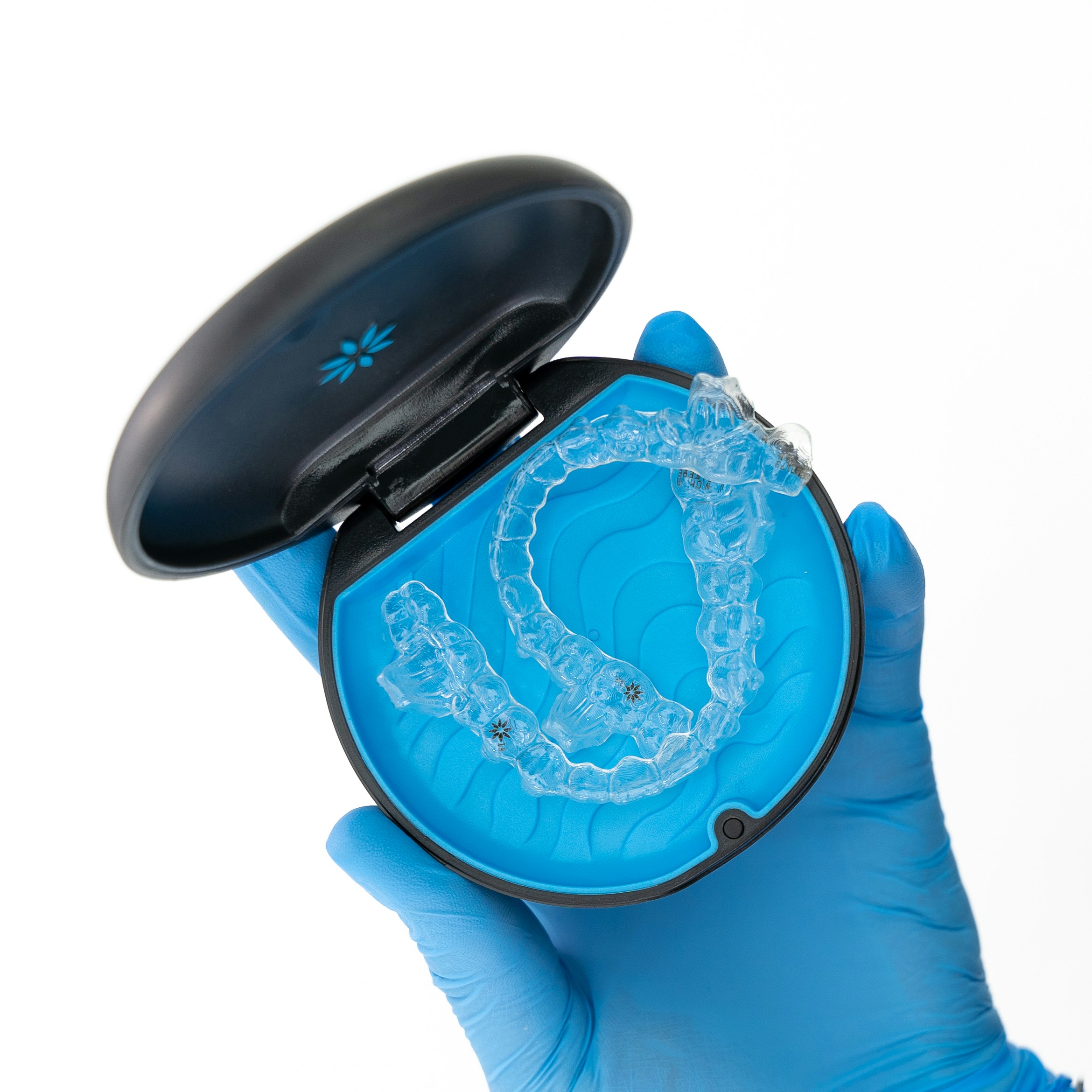
Invisalign clear aligners
The Invisalign Process
- Consultation: The journey begins with a consultation where the dentist evaluates your dental structure and discusses whether Invisalign is the right choice for you.
- Custom Treatment Plan: Using 3D imaging technology, the dentist creates a precise treatment plan that maps out the movement of your teeth. This plan allows you to see the expected changes and final outcome before starting the treatment.
- Receiving Your Aligners: Based on the treatment plan, custom aligners are created. You’ll wear each set of aligners for about two weeks before switching to the next set in the series, gradually moving your teeth toward the desired alignment.
- Regular Check-ups: Periodic dental visits are scheduled to monitor progress and ensure the treatment is proceeding as planned.
- Completion and Retention: After completing all the aligner sets, you may need to wear retainers to keep your teeth in their new position and prevent them from shifting back.
Cost of Invisalign
Invisalign can be more expensive than traditional braces, with costs varying based on the complexity of the case, the duration of treatment, and geographic location. The higher cost reflects the advanced technology and custom manufacturing of the aligners. Many dental insurance plans now cover Invisalign to the same extent they cover braces, so it’s worth checking with your insurance provider.
Invisalign vs. Traditional Braces
Reasons someone might choose Invisalign over traditional braces include:
- Aesthetics: Invisalign’s clear aligners are less noticeable than metal braces, making them a popular choice for adults and teens who are self-conscious about their appearance.
- Comfort: The smooth plastic aligners are generally more comfortable and less likely to irritate the cheeks and gums than the wires and brackets of braces.
- Convenience: Invisalign aligners are removable, making it easier to eat, brush, and floss, which can lead to better oral hygiene during treatment.
- Predictability: Using 3D imaging technology, Invisalign allows patients and dentists to visualize the entire treatment plan from start to finish, even before the treatment begins.
- Fewer Office Visits: Invisalign often requires fewer check-ups and adjustments than traditional braces, as several sets of aligners are provided at once, reducing the number of visits to the orthodontist.
When Is a Tooth Extraction Necessary?

- Severe Decay or Infection: When a tooth is badly decayed and cannot be saved with a filling, crown, or other treatment, extraction may be necessary to prevent the spread of infection to surrounding teeth and bone.
- Periodontal (Gum) Disease: Advanced gum disease can cause the supporting tissue and bone structures of the teeth to deteriorate, leading to tooth loosening and requiring extraction.
- Overcrowding or Orthodontic Preparation: To align the teeth properly, orthodontic treatment sometimes requires the removal of one or more teeth to relieve overcrowding or to create space for the remaining teeth to move into place.
- Impacted Teeth: Teeth that are blocked from erupting properly, often seen with wisdom teeth, can become impacted and may need to be extracted to prevent pain, infection, or damage to adjacent teeth.
- Risk of Infection: In some cases, teeth may be extracted as a preventative measure if they are at risk of infection, such as in the case of compromised immune systems or in preparation for chemotherapy or organ transplantation where the risk of infection needs to be minimized.
- Trauma or Injury: Teeth that are severely damaged due to trauma or accidents and cannot be repaired may need to be extracted to prevent further complications and to preserve oral health.
If you are in pain while waiting for your dental procedure, the DenTek Instant Oral Pain Relief Maximum Strength Kit can provide quick and effective relief.
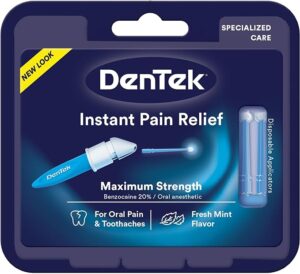 |
This portable kit contains single-use applicators filled with a maximum strength formula that targets the source of your tooth pain. The easy-to-use applicators allow you to precisely apply the medication directly to the affected area, providing fast-acting relief.
5 Questions to Ask Before You Get Dentures

- How do dentures feel, and will they affect my speech or eating?
Initially, new dentures may feel unfamiliar or bulky in the mouth, leading to a period of adjustment where speech and eating might be affected. Some people experience an increase in saliva flow, minor irritation, or soreness as their mouth gets accustomed to the dentures. With time, these sensations generally diminish, allowing speech to return to normal. Eating will also take some getting used to; starting with soft foods cut into small pieces can help. An interesting fact is that dentures can actually improve your speech if you’ve had missing teeth for a while, as they restore the ability to pronounce certain sounds more clearly.
- How do I care for my dentures?
Dentures require daily cleaning to remove food particles and plaque, prevent staining, and maintain oral health. Unlike natural teeth, dentures should be cleaned with a soft-bristle brush and non-abrasive cleaners specifically designed for them, as regular toothpaste can be too harsh. Soaking dentures in a cleaning solution overnight can help to disinfect them and remove stains. Additionally, it’s crucial to keep the gums and mouth clean to prevent infections. When cleaning, fill the sink with water or place a towel underneath while handling dentures to avoid damage if they are accidentally dropped.
- How long do dentures last?Dentures typically last between 5 to 10 years, but this can vary based on factors like the wearer’s oral habits, care routine, and changes in the mouth’s shape. Over time, dentures may require adjustments or relining due to natural changes in the jaw and gums. Regular dental check-ups are important to assess the fit and condition of the dentures. Even with good care, the material of dentures can wear down or lose its shape, requiring their replacement to ensure optimal function and comfort.
- Will my dentures look like natural teeth?Modern dentures are designed to look very similar to natural teeth, with attention to detail in the color, shape, and placement of the artificial teeth to match the wearer’s facial structure and skin tone. Advances in dental technology have led to more realistic and aesthetically pleasing results, making it difficult for others to notice that someone is wearing dentures. The acrylic base used in dentures can be tinted to match the natural gum color, enhancing the overall natural appearance.
- What is the cost of getting dentures, and does insurance cover them?The cost of dentures can vary widely depending on the type (full or partial), materials used, and the complexity of the case. Basic dentures can range from a few hundred to several thousand dollars. Most dental insurance plans typically cover a portion of the cost of dentures, but the extent of coverage can vary significantly. It’s important to check with your insurance provider for specific details about their coverage. Some dental clinics offer financing plans or sliding scale fees based on income, making dentures more accessible to a broader range of patients.
Dental Checkup and Teeth Cleaning
Why Dental Checkups and Cleaning are a Must
A dental checkup and cleaning is important, as it serves as a preventive measure and a diagnostic tool. It comprises several key components:
- Examination of Oral Health: This step is where we inspect your teeth, gums, bite, and jaw for signs of decay, gum disease, or other issues. It’s a thorough process to ensure nothing is amiss.
- Cleaning and Polishing: We remove plaque and tartar buildup that brushing and flossing at home can’t manage. This cleaning and polishing prevents cavities and gum disease and leaves your teeth feeling fresh and smooth.
- X-Rays: Depending on your oral health status and age, we might take X-rays to spot hidden problems, like impacted teeth, bone loss, or cavities between teeth, ensuring a comprehensive view of your dental health.
- Education and Prevention: Empowering you with knowledge, we offer personalized advice on oral hygiene practices, diet, and lifestyle choices that can enhance your oral health.
The significance of regular dental checkups cannot be overstated:
- Early Detection of Problems: Identifying dental issues early can lead to simpler, more effective treatments, saving you from future discomfort and expense.
- Prevention of Disease: Regular cleanings are crucial in preventing the onset of oral diseases by managing plaque and tartar buildup.
- Maintaining Overall Health: Oral health is linked to systemic health, making dental checkups a vital part of your healthcare routine.
- Professional Guidance: Tailored advice during these visits helps improve your daily oral care, contributing to long-term dental health.
- Cost-Effective: Preventative care through regular checkups wards off the need for more complex and expensive treatments down the line.
- Halitosis Prevention: By removing plaque, tartar, and bacteria, cleanings help prevent bad breath, keeping your mouth fresh.
How Often Do I Need Dental Checkup and Cleanings?
Dental checkups and cleanings are typically recommended every six months for most people. However, the frequency can vary based on individual oral health needs. If you have a higher risk of dental disease due to smoking, diabetes, a weak immune responses, or a history of plaque buildup or cavities, you might need more frequent dental care. Children and older adults may require more frequent checkups as well, to monitor developmental changes and manage age-related dental issues.
Full vs Partial Dentures
The Purpose of Dentures
Dentures are prosthetic devices designed to replace missing teeth, support facial muscles, and improve your ability to eat and speak with ease.
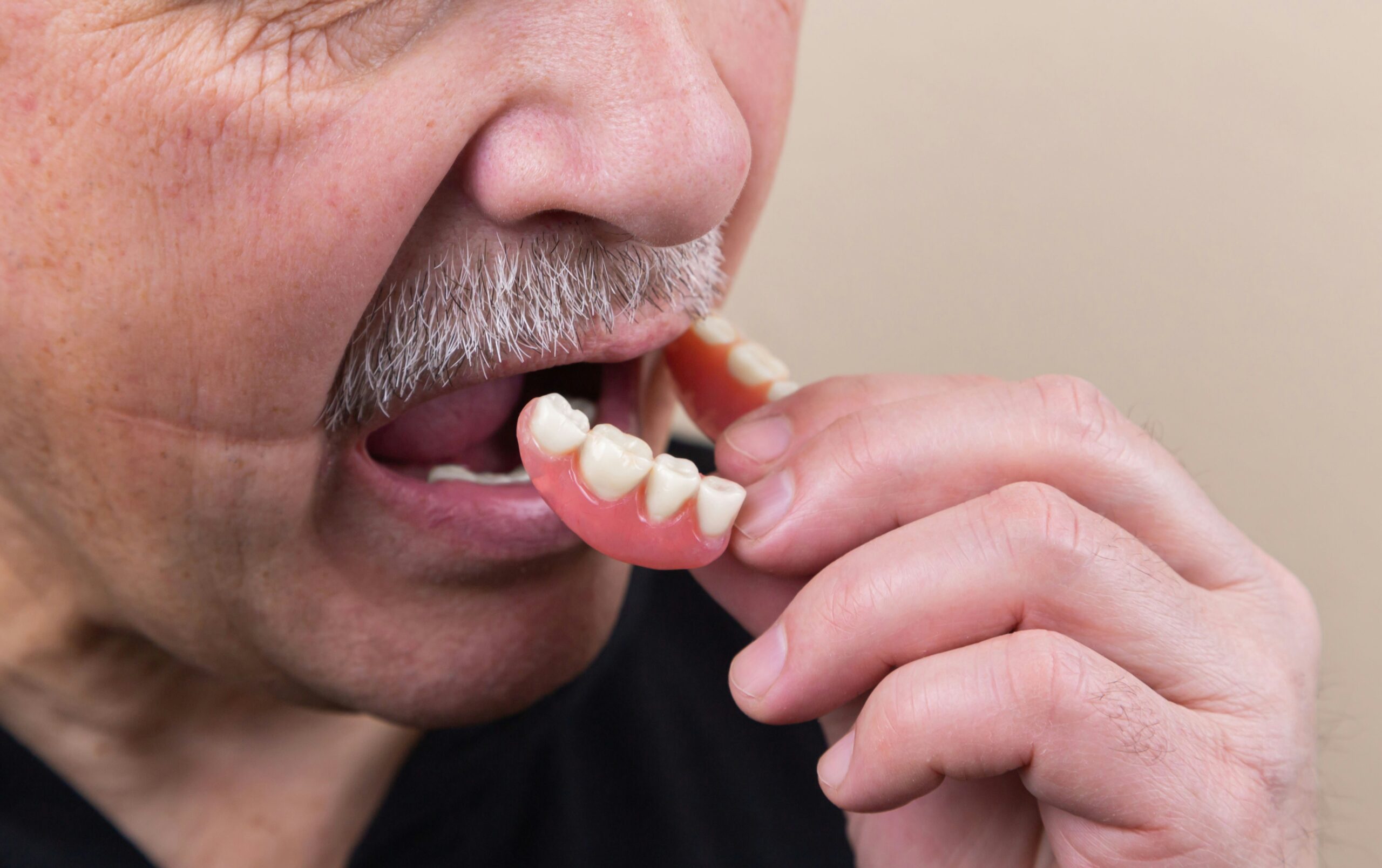
Full Dentures
Understanding Partial vs Full Dentures
Partial dentures are designed for individuals who still have some natural teeth remaining, acting as a bridge to fill in the gaps left by missing teeth and prevent the remaining teeth from shifting position. They are usually preferred when the natural teeth are strong enough to support the structure of the denture. On the other hand, full dentures are required when all the teeth in either the upper or lower jaw (or both) are missing, providing a complete replacement that rests on the gums.
How are Full and Partial Dentures Held in Place?
Partial dentures are typically held in place by clasps or precision attachments that fit around some of the remaining natural teeth. These clasps can be made of metal or a tooth-colored material, designed to be both functional and aesthetically pleasing. The partial denture fills in the space left by missing teeth and prevents the other teeth from changing position. Some partial dentures are removable, making them easy to clean, while others can be fixed (also known as bridges), offering a more permanent solution. The stability and retention of a partial denture depend greatly on the health and positioning of the remaining natural teeth that serve as anchors.
Full dentures, on the other hand, are held in place primarily through suction and, in some cases, adhesive creams or gels. The base of a full denture is designed to closely fit the contours of the individual’s gums and the roof of the mouth (for upper dentures), creating a vacuum that secures the denture in place. Lower full dentures rely more on the gum line’s shape for stability and can be more challenging to keep in place due to the tongue’s movements. Denture adhesives can be used to improve the fit and feel of full dentures, providing additional security and comfort.
Both types of dentures may require adjustments over time to maintain a good fit, as the mouth’s shape changes due to factors like bone resorption and gum shrinkage. Regular dental check-ups are important for denture wearers to ensure their dentures continue to fit well and remain comfortable. Additionally, advancements in dental technology, such as implant-supported dentures, offer alternative methods to increase the stability and retention of both partial and full dentures, providing options for those seeking a more secure fit.
How Do I Care for Full or Partial (Removable) Dentures?
- Daily Cleaning: Both full and partial (removable) dentures should be removed and cleaned daily using a soft-bristle denture brush and a non-abrasive cleaner specifically designed for dentures. Regular toothpaste should be avoided as it can be too harsh and scratch the denture surface.
- Rinse After Eating: Remove and rinse the dentures after eating to clear away food remnants and plaque.
- Soak Overnight: Both full and partial dentures should be soaked in water or a mild denture-soaking solution overnight as recommended by your dentist, but this is especially important for full dentures, as most of them need to remain moist to keep their shape.
- Avoid Certain Products: Don’t use abrasive cleaners, bleaches, or boiling water to clean dentures, as these can damage them.
How Do I Care for Fixed Partial Dentures / Dental Bridges?
- Brush Regularly: Use a soft-bristled toothbrush to clean the surface of the dentures and your natural teeth. Brush at least twice a day to remove plaque and prevent tartar buildup.
- Use Floss Threaders: Floss threaders can help you guide dental floss under the fixed partial denture to clean the area between the denture and your natural gums, reducing the risk of gum disease and tooth decay.
- Water Flossers: A water flosser can be an effective tool for cleaning around fixed partial dentures, providing a stream of water that can help dislodge food particles and plaque.
- Professional Cleanings: Schedule professional cleanings as recommended by your dentist to remove tartar and plaque that can’t be eliminated with home care.
Metal Braces vs Clear Braces vs Invisalign
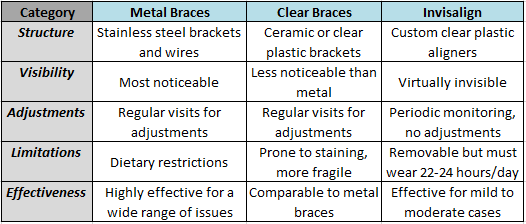
A quick comparison between the three most common types of aligners
Metal Braces
Metal Braces have been the cornerstone of orthodontic treatment for decades, known for their durability and effectiveness in treating a wide range of dental misalignments and bite issues. Their robust design involves stainless steel brackets and wires that apply continuous pressure to teeth, gradually moving them into the desired position. While their visibility is often cited as a drawback, especially among adult patients, the option for colored bands adds a fun element for younger users. Metal braces are especially valued for their capability to address severe and complex orthodontic cases.
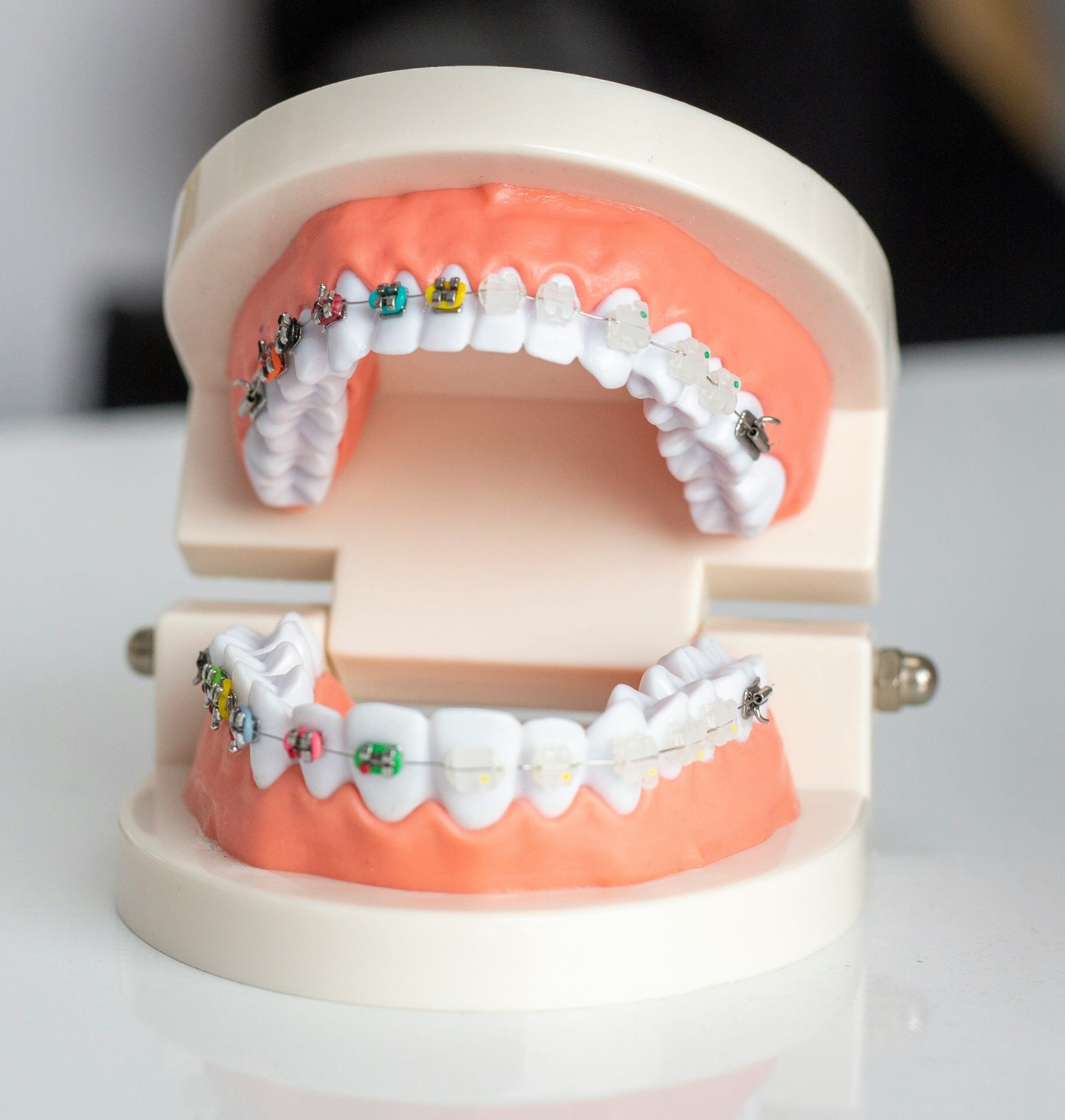
Metal vs Clear Braces
Clear Braces
Clear Braces, on the other hand, offer a more aesthetic alternative while utilizing the same mechanics as their metal counterparts. Comprised of ceramic or high-quality plastic, clear braces blend more seamlessly with the natural color of the teeth, making them less noticeable at a glance. This feature is particularly appealing to adults and teens who are conscious about the appearance of braces in social or professional settings. However, it’s important to note that clear braces may require more meticulous care to prevent staining and are slightly more prone to breakage than metal braces.
Invisalign

Invisalign
Invisalign represents a leap forward in orthodontic technology, offering a virtually invisible solution to teeth straightening. This system uses a series of custom-made, clear plastic aligners that fit snugly over the teeth. Patients appreciate the discretion Invisalign provides, as well as the flexibility to remove the aligners for eating, drinking, and oral hygiene practices. While Invisalign is highly effective for mild to moderate alignment issues, it may not be suitable for more complex orthodontic needs. Additionally, the success of Invisalign treatment relies heavily on the patient’s commitment to wearing the aligners as prescribed, typically 22 to 24 hours a day.
FAQs
- Can Invisalign treat all the same issues as braces?
No, Invisalign is generally recommended for mild to moderate issues.
- Are clear braces as effective as metal braces?
Yes, they can be just as effective, though the material may not be as durable.
- How long does treatment take?
Treatment times vary, but metal braces often offer the quickest solution.
- Is there an age limit for any of these treatments?
No, but treatment plans may vary based on age-related factors.
Disclosure
WEBSITE DISCLAIMER
The information provided by us on https://ny1dentist.com/ (the “Site”) is for general informational purposes only. All information on the Site is provided in good faith, however we make no representation or warranty of any kind, express or implied, regarding the accuracy, adequacy, validity, reliability, availability, or completeness of any information on the Site. UNDER NO CIRCUMSTANCE SHALL WE HAVE ANY LIABILITY TO YOU FOR ANY LOSS OR DAMAGE OF ANY KIND INCURRED AS A RESULT OF THE USE OF THE SITE OR RELIANCE ON ANY INFORMATION PROVIDED ON THE SITE. YOUR USE OF THE SITE AND YOUR RELIANCE ON ANY INFORMATION ON THE SITE IS SOLELY AT YOUR OWN RISK.
EXTERNAL LINKS DISCLAIMER
The Site may contain (or you may be sent through the Site) links to other websites or content belonging to or originating from third parties or links to websites and features in banners or other advertising. Such external links are not investigated, monitored, or checked for accuracy, adequacy, validity, reliability, availability, or completeness by us. WE DO NOT WARRANT, ENDORSE, GUARANTEE, OR ASSUME RESPONSIBILITY FOR THE ACCURACY OR RELIABILITY OF ANY INFORMATION OFFERED BY THIRD-PARTY WEBSITES LINKED THROUGH THE SITE OR ANY WEBSITE OR FEATURE LINKED IN ANY BANNER OR OTHER ADVERTISING. WE WILL NOT BE A PARTY TO OR IN ANY WAY BE RESPONSIBLE FOR MONITORING ANY TRANSACTION BETWEEN YOU AND THIRD-PARTY PROVIDERS OF PRODUCTS OR SERVICES.
PROFESSIONAL DISCLAIMER
The Site cannot and does not contain medical/health advice. The medical/health information is provided for general informational and educational purposes only and is not a substitute for professional advice. Accordingly, before taking any actions based upon such information, we encourage you to consult with the appropriate professionals. We do not provide any kind of medical/health advice. THE USE OR RELIANCE OF ANY INFORMATION CONTAINED ON THE SITE IS SOLELY AT YOUR OWN RISK.
AFFILIATES DISCLAIMER
The Site may contain links to affiliate websites, and we receive an affiliate commission for any purchases made by you on the affiliate website using such links. Our affiliates include the following:
- Max Bounty
Updated Apr 3, 2024
Is Sedation Recommended for Root Canal Treatment?

Do You Get Put to Sleep for a Root Canal?
The short answer is no. Sedation is usually not recommended for root canals, but there are some exceptions where sedation for a root canal is an option. Typically, a local anesthesia is applied to the affected area to numb the tooth and surrounding tissue, ensuring that the procedure is as comfortable as possible for the patient. The idea is to alleviate any pain without the need for general anesthesia, which is where you would be “put to sleep.”
However, for patients who experience severe dental anxiety or have certain medical conditions, sedation dentistry options are available. These can range from mild sedatives to help relax you, to more moderate forms of sedation where you’re awake but in a deeply relaxed state. In rare cases, and under the guidance of a dentist or an oral surgeon who specializes in sedation, general anesthesia may be used. This is usually reserved for extreme cases of anxiety, very complex dental issues, or when multiple procedures are being done at the same time.
It’s important to have an open conversation with your dentist about your concerns and any anxiety you might have regarding dental procedures. They can provide detailed explanations of what to expect, discuss sedation options, and tailor the approach to suit your needs and comfort level.
If you are in pain while waiting for your root canal procedure, the DenTek Instant Oral Pain Relief Maximum Strength Kit can provide quick and effective relief.
 |
This portable kit contains single-use applicators filled with a maximum strength formula that targets the source of your tooth pain. The easy-to-use applicators allow you to precisely apply the medication directly to the affected area, providing fast-acting relief.
Debunking the Pain Myth: Modern Advances in Root Canal Therapy
Historically, the state of dental technology and anesthesia left much to be desired compared to today’s advancements. As a result, dental procedures, especially root canals, were significantly more uncomfortable and painful than they are today. However, modern advances in dental technology and techniques have significantly transformed this procedure into a much more comfortable experience for patients. The advent of advanced imaging techniques allows for more accurate diagnosis and treatment planning, ensuring that the procedure is as efficient and effective as possible. Furthermore, the development of better anesthetic agents and more sophisticated methods of application ensures that the treatment area is numbed effectively, reducing or eliminating pain during the procedure. These technological and pharmacological advances, combined with the skill of experienced dental professionals, make the sensation during a root canal no more uncomfortable than receiving a filling.
In addition to the pain patients worry about during the root canal procedure, they worry about post-procedure pain as well. Post-procedure discomfort has been greatly minimized thanks to improved techniques and materials used in the filling and sealing process. Patients may experience some sensitivity following the procedure, but this is typically mild and short-lived. Over-the-counter pain relief medications are usually sufficient to manage any post-treatment discomfort.
If you are still worried about the pain of a root canal, consider that more often than not, the discomfort people associate with a root canal actually stems from the infection that requires the treatment, rather than the procedure itself. A root canal aims to alleviate this discomfort by removing the infected pulp, effectively addressing the root cause of the pain.
